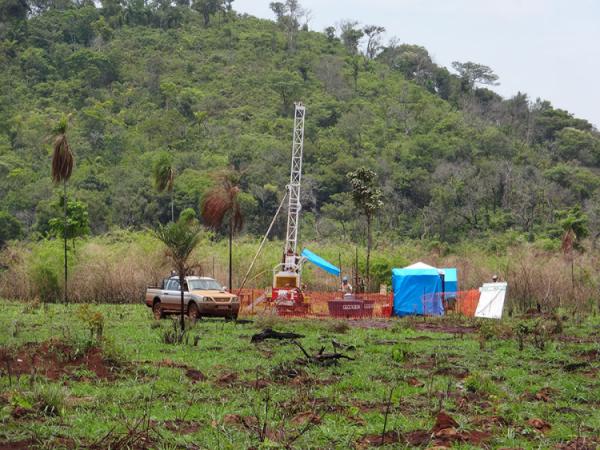Horizonte Brings A Heavyweight Collection Of Canadian Investors Onto The Register, As Araguaia Moves Towards Definitive Feasibility

By Alastair Ford
“We closed off on Monday on the US$10 million financing”, says Jeremy Martin, the chief executive of Horizonte Minerals.
“It was a good achievement. Sixty per cent of the money came from Canada, from new institutions in Canada. So now we’ve got stock in the market over there we can market over there.”
That’s significant because in recent years the Canadian market has shown more appreciation for nickel juniors built in the mould of Horizonte than the London market has. In part that’s because there have been several nickel success stories born out of the Canadian capital markets, most notably Inco and Falconbridge.
“Most brokerages have got a Falconbridge person somewhere in their ranks”, says Jeremy, By contrast, the London market’s relationship to nickel has been more chequered. With the honourable exception of Mwana Africa, which is producing a nickel concentrate at profit in Zimbabwe, most of Aim’s nickel companies are sitting on projects with unproven processing routes.
There’s also been a couple of high profile failures, notably the collapse of African Eagle last year, and the ongoing travails of European Nickel, which foundered on the rocks of Turkish bureaucracy and was eventually gobbled up by an Australian rival.
So, while this year’s surge in the nickel price has resulted in healthy double digit share price increases for nickel companies on the Toronto Exchange, and indeed in Australia, the nickel companies on Aim have languished.
Horizonte wants to break that mould by driving trade into Canada, and its efforts will be well supported by its plans to use a Rotary Kiln Electric Furnace smelting line to process its ore. RKEF is a tried and tested route that’s already in operation at several projects across the globe, including at the nearby Onca Puma project in Para State, one of the largest ferronickel operations in the world.
The execution risk of RKEF is therefore far lower than any of the more speculative routes that might have been used such as high pressure acid leaching or atmospheric leaching. “RKEF has been banked”, says Jeremy. “We’ve got a good handle on how it works.”
The plan now is to drive Araguaia forward to the completion of a definitive feasibility study next year. “Initially there will be a 15,000 metre drill programme to convert probable reserves to proven”, says Jeremy.
“Then we will do a pilot campaign. The contracts for the DFS will be awarded towards the end of this year. It’s going to be busy. A number of engineering groups are coming into the mix too, so we hope to see a major engineering group on board. The next thing is going to be looking at the financing to get this thing built.”
Location of Araguaia
That will be no small undertaking, as pre-production capital was estimated at US$582 million in a pre-feasibility study that was completed earlier this year. There may be some wriggle room on that when the definitive numbers are drawn up, but the fact remains that it’s a huge sum for a company with a market capitalisation of less than £25 million.
Horizonte has a trick up its sleeve though. Alongside the new Canadian institutions there sits another extremely influential existing Canadian shareholder – Teck Resources. Teck has been a long-time backer of Horizonte and, true to form, followed its money in the most recent raise.
“They’ve been supportive”, says Jeremy. “They have a board seat in Alex Christoper, Tekc’s global head of exploration. And this is their pattern – they incubate through to feasibility.”
What Teck’s ultimate role in the future of Araguaia will be remains to be seen, but having a friendly and well established mining giant on the register does at least mean that Horizonte is unlikely ever to be taken out by a low-ball hostile bidder taking advantage of a weakening of the nickel price or a slackening in the mining equity markets.
It also means that should the construction of Araguaia continue under Horizonte’s auspices, one major source of finance should already be in place. “Our focus is to take Araguaia forward as a standalone project”, Jeremy emphasises. “The plan is to produce 15,000 tonne of ferro-nickel per year.”
And at the moment, the prevailing winds for Horizonte are looking extremely favourable. The nickel price has strengthened considerably since the beginning of the year, as the Indonesian government has restricted the exporting of unprocessed ores and supply has accordingly tightened. “The situation in Indonesia has been good in terms of pricing and also in terms of new entrants like stainless steel companies looking for security of supply”, says Jeremy. “And the general consensus is that the Indonesian ban is in place for the longer term.”
He points out that for the time being, in terms of stockpiles on the LME, the market remains in surplus. But that surplus could turn to deficit next year. “If the ore ban holds we could be in for a couple of interesting years ahead in terms of nickel pricing.”
Which brings us back to Araguaia, and the ongoing work there. Typically, says Jeremy, there is a big value uplift in projects of this type as they move through from pre-feasibility to definitive feasibility. “There’s still huge value in this.”
Comments (0)